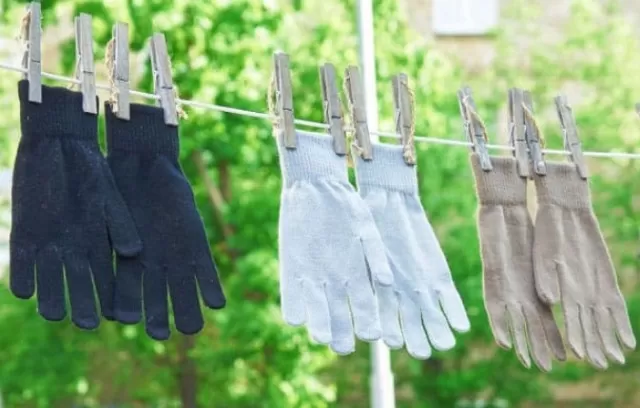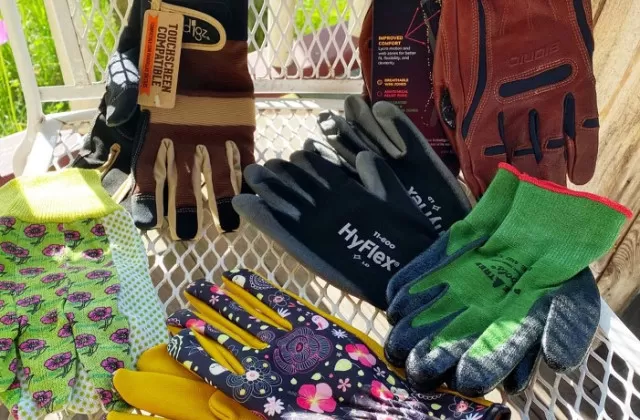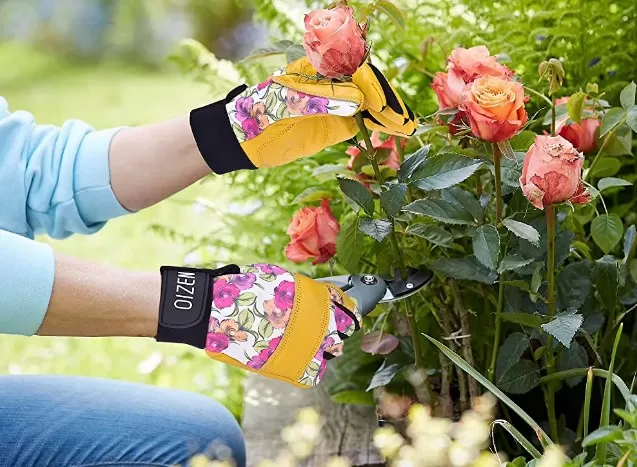Washing and Maintaining Your Gardening Gloves.
Maintaining the essential tools of a gardener’s trade—their hands—requires the use of gardening gloves.
These gloves shield against thorns, chemicals, and the constant need for manicures. Depending on their material, gardening gloves can be made of leather, cotton, rubber (such as latex or neoprene), or a combination of fabrics and synthetic materials. Properly washing them is crucial, especially after handling chemicals or diseased plants, to prevent the spread of problems and prolong their lifespan.
Here’s a guide on how to wash and care for your gardening gloves based on their material:
Leather gloves
Spot clean leather gloves by wiping them with a damp cloth to remove dirt and stains. Avoid soaking or submerging them in water. Apply a leather conditioner to keep them supple and prevent cracking. Air dry them away from direct heat or sunlight.
Cotton gloves
Cotton gloves are usually machine washable. Check the care instructions on the gloves for specific temperature and washing recommendations. Use mild detergent and wash them on a gentle cycle. Air dry them or tumble dry on low heat.
Rubber or latex gloves
Rinse rubber or latex gloves thoroughly with water to remove dirt and chemicals. Apply a small amount of mild Dish Soap and gently rub the gloves to clean them. Rinse again to remove any soap residue. Hang them to air dry or place them in a well-ventilated area away from direct heat or sunlight.
Synthetic or fabric gloves
Check the care instructions for specific recommendations. Some synthetic or fabric gloves can be machine washed on a gentle cycle using mild detergent. Air dry them or tumble dry on low heat if allowed.
Additional tips for glove care
Always remove gloves carefully to avoid tearing or damaging them.
Store gloves in a cool, dry place to prevent mold or mildew growth.
Avoid exposing gloves to excessive heat or direct sunlight, as it can degrade the materials.
Inspect gloves regularly for signs of wear and tear, and replace them when necessary.
Remember, while perfectly clean gloves are a rarity among dedicated gardeners, knowing how to effectively wash and care for your gardening gloves will help maintain their functionality and prolong their usefulness.
Caring for Knit Gloves: Proper Washing Techniques for Cotton and Synthetic Fiber Gloves

Proper Care for Cotton or Synthetic Fiber Knit Gloves: Washing Guide.
If you have gloves made of fabric or gloves with palms coated in latex, nitrile, neoprene, or PVC, follow these steps for washing:.
Rinse off loose soil
Use a garden hose or a bucket of water to rinse away surface dirt.
You can keep the gloves on your hands and rub them together under running water or in the water-filled bucket to loosen the soil.
Select washer settings
Set your washing machine to the regular cycle with cold water.
Pretreat stains (if needed)
If you have stubborn stains, apply a small amount of laundry detergent to the stained areas.
Use your fingers or a soft-bristled nylon brush to work the detergent into the fabric. Allow the gloves to sit for about 10 minutes to let the detergent break down the stains.
Wash the gloves
You can wash the gloves with a load of similar colors and fabrics.
Place them in a mesh lingerie bag to keep them together and prevent tangling. If you prefer handwashing, follow the same pre-wash steps.
Use cold water and regular detergent. Swish and squeeze the gloves in the soapy solution, then let them soak for at least 10 minutes.
Drain the Soapy Water and refill the sink or bucket with clean water for rinsing. Gently squeeze the gloves to remove all the soap.
Hang to air-dry
Avoid using a dryer, as the heat can cause shrinkage or damage to neoprene-lined palms.
Instead, hang the gloves on a clothes drying rack or outdoor clothesline. Allow them to air-dry completely.
By following these instructions, you can effectively wash and care for your cotton or synthetic fiber knit gloves, ensuring their longevity and maintaining their functionality for future gardening endeavors.
Cleaning Rubber Gardening Gloves: Step-by-Step Washing Instructions

Cleaning and Drying Rubber Gardening Gloves: A Step-by-Step Guide.
Rubber gardening gloves, including those made of latex, neoprene, nitrile, or PVC, are excellent for handling fertilizers, pesticides, or herbicides.
When washing rubber gloves used for spreading chemicals, it’s important not to wash them with other gloves. Follow these steps to properly wash and dry your rubber gardening gloves:.
Pre-rinse the gloves
While still wearing the gloves, hold them under a stream of cold water from a garden hose or utility sink.
This helps remove any loose dirt or debris.
Wash the gloves
While still wearing the gloves, use a bar of soap or a few drops of dishwashing liquid to wash the gloves.
Gently rub the soap against the gloves, focusing on any tough stains. If needed, you can use a soft-bristled nylon brush to scrub the stains gently.
Rinse the gloves
Remove the gloves and thoroughly rinse both the outside and inside of the gloves with cold water.
Ensure all soap residue is rinsed away.
Hang to air-dry
Hang the gloves by their fingertips on a clothes drying rack or an outdoor clothesline.
It’s essential for the gloves to dry quickly to prevent mildew formation on the inside. Once the outside is dry, turn the gloves inside out to allow the inside to dry thoroughly before storing them.
By following these steps, you can effectively wash and dry your rubber gardening gloves, ensuring they remain clean and ready for your next gardening session.
Caring for Leather Gardening Gloves: Proper Washing Techniques

Maintaining Leather Gardening Gloves: Step-by-Step Washing Instructions.
Leather gardening gloves provide excellent protection for heavy-duty tasks like moving stones or pruning thorny shrubs, but they require proper care to prevent drying out and cracking.
Follow these steps to wash and maintain your leather gardening gloves:.
Remove loose soil
Use a soft-bristled brush to gently remove any loose soil from the gloves.
If the gloves are damp and muddy, allow them to dry first, and then brush away the soil.
Clean with saddle soap
Leather gloves should be cleaned with a gentle leather soap such as saddle soap or Castile soap.
Do not use regular laundry detergent. Apply the saddle soap using a washcloth, using gentle circular motions.
Transfer to a clean area of the cloth as soil is transferred. Once the entire surface of the gloves has been cleaned, dampen a clean washcloth and wipe away the soap.
Air-dry the gloves
Allow the gloves to air-dry away from direct sunlight or heat sources.
Avoid using a dryer or exposing them to excessive heat, as it can damage the leather.
Condition the leather gloves: After cleaning and drying, it’s essential to condition the leather to keep it soft and supple.
Use linseed oil or a commercial leather conditioner. Apply a small amount to a soft, dry washcloth and gently rub it into the gloves.
Ensure the conditioner is evenly distributed. Allow the gloves to air-dry completely before storing.
By following these steps, you can effectively wash and maintain your leather gardening gloves, preventing them from drying out and cracking.
Proper care will help extend their lifespan and keep them in optimal condition for your gardening needs.

Maintaining Garden Gloves: Stain Treatment, Care, and Washing Tips.
Garden gloves are designed to get dirty, and stains are not a significant concern.
However, it’s still essential to properly care for and clean your gloves. Here are some tips for treating stains, caring for and repairing gloves, storing them, and washing them:
Treating Stains on Garden Gloves
Stains on garden gloves, regardless of the material, are generally not a major issue.
Remember that garden gloves are meant to get dirty due to their intended use. Focus on regular cleaning rather than worry about minor stains.
Garden Glove Care and Repairs
Small holes in cotton or synthetic knit gloves can be repaired with a needle and thread.
Rubber or leather gloves may be temporarily fixed by applying a coating of Plasti Dip to stop fraying or patch tiny holes. However, replacing damaged gloves is often a better option to ensure hand protection.
Storing Garden Gloves
Ensure gloves are thoroughly dry after cleaning to prevent mildew.
Store gloves in a dry, conditioned space. Clip gloves together and hang them on the inside wall of your garage to promote air circulation and prevent mold and mildew.
How Often to Wash Gardening Gloves
Clean your gardening gloves every time you use them, regardless of the material.
This is especially important if you have come into contact with infected plants or chemicals to prevent the spread of toxins to healthy parts of your garden.
Tips for Washing Gardening Gloves
Check the cleaning instructions for your leather garden gloves.
Some may be machine washable, while others require conditioning rather than washing. When washing cotton gloves, pay special attention to cleaning the cuff area where dirt and debris tend to accumulate.
Rubber gloves are easy to clean since they do not absorb water. However, they are prone to mold and mildew, so ensure they are thoroughly dried and stored properly between uses.
Hanging them up with a clip can help keep them dry and well-aired. Monitor the shape of your gloves as they dry, especially heavy-duty rubber or leather gloves.
Reshape the fingers as needed to prevent them from becoming misshapen. By following these guidelines, you can effectively treat stains, care for, store, and wash your gardening gloves, ensuring their durability and maintaining a hygienic gardening practice.
*The information is for reference only.